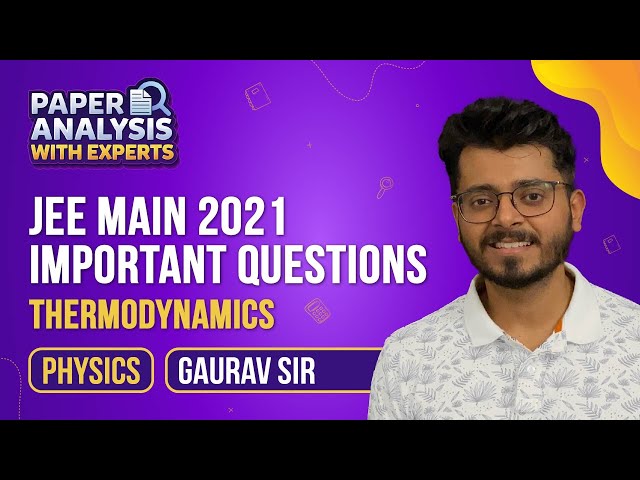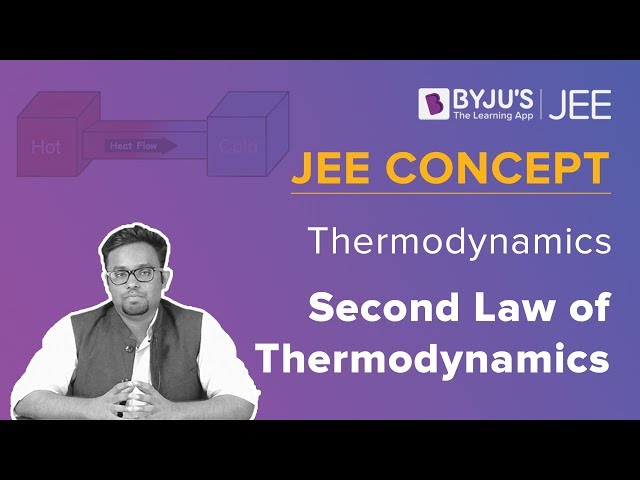Thermodynamics is the branch of Physics that deals with the relationships between heat, work, temperature and energy. The term Thermodynamics means heat movement or heat flow. It mainly deals with the conversion of thermal energy from and to other forms of energy and its impact on the matter. The vibrating or moving molecules possess thermal energy due to the change in temperature.
This section contains, important laws of Thermodynamics and previous year questions with solutions are provided. Candidates should practice solving the question papers on a regular basis to secure a meritorious position and even crack the examination.
Download Previous Year Solved Questions on Thermodynamics PDF
Important Laws of Thermodynamics:
There are four laws of thermodynamics,
Zeroth Law of Thermodynamics
The Zeroth Law is the basis for the measurement of temperature.
It states that: Two bodies which are in thermal equilibrium with a third body are in thermal equilibrium with each other.
First Law of Thermodynamics
According to the First Law of Thermodynamics heat is a form of energy and it obeys the law of conservation of energy. This means that heat energy cannot be created or destroyed. It can, however, be transferred from one location to another and converted to and from other forms of energy.
Second Law of Thermodynamics
According to the second law of thermodynamics, any spontaneously occurring process will lead to an increase in the entropy of the universe. In other words, the entropy of an isolated system will never decrease over time. In some cases where the system is in thermodynamic equilibrium or going through a reversible process, the total entropy of a system and its surroundings remain constant. The second law is also known as the Law of Increased Entropy.
Third Law of Thermodynamics
The Third Law states that: The entropy of a perfect crystal is zero when the temperature of the crystal is equal to absolute zero (0 K).
JEE Main Thermodynamics Previous Year Solved Questions
Q1: “Heat cannot by itself flow from a body at a lower temperature to a body at a higher temperature” is a statement or consequence of
(a) The second law of thermodynamics
(b) conservation of momentum
(c) conservation of mass
(d) The first law of thermodynamics
Answer: (a) Second law of thermodynamics.
Q2: Which of the following is incorrect regarding the first law of thermodynamics?
(a) It introduces the concept of internal energy
(b) It introduces the concept of entropy
(c) It is not applicable to any cyclic process
(d) It is a restatement of the principle of conservation of energy
Answer: Statements (b) and (c) are incorrect regarding the first law of thermodynamics.
Q3: Which of the following statements is correct for any thermodynamic system?
(a) The internal energy changes in all processes
(b) Internal energy and entropy are state functions
(c) The change in entropy can never be zero
(d) The work done in an adiabatic process is always zero
Answer: (b) Internal energy and entropy are state functions
Q4: Which of the following parameters does not characterize the thermodynamic state of matter?
(a) temperature
(b) pressure
(c) work
(d) volume
Answer: (c): The work does not characterize the thermodynamic state of matter
Q5: Even a Carnot engine cannot give 100% efficiency because we cannot
(a) prevent radiation
(b) find ideal sources
(c) reach absolute zero temperature
(d) eliminate friction.
Answer: (c): We cannot reach absolute zero temperature
Q6: Which statement is incorrect?
(a) All reversible cycles have the same efficiency
(b) The reversible cycle has more efficiency than an irreversible one
(c) Carnot cycle is a reversible one
(d) Carnot cycle has the maximum efficiency in all cycles
Answer: (a) All reversible cycles do not have the same efficiency.
Q7: A Carnot engine operating between temperatures T1 and T2 has efficiency 1/6. When T2 is lowered by 62 K, its efficiency increases to ⅓. Then T1 and T2 are, respectively
(a) 372 K and 310 K
(b) 372 K and 330 K
(c) 330 K and 268 K
(d) 310 K and 248 K
Solution
The efficiency of Carnot engine,
η =1- (T2/T1)
η = ⅙
T2/T1 = ⅚
T1 = 6T2/5 ————–(1)
As per the question, when T2 is lowered by 62 K, then its efficiency becomes 1/3
⅓ = [1 – (T2 -62/T1)] [T2 -62/T1 ] = 1-(⅓) (Using equa (1))
5(T2 -62)/6T2= ⅔
5T2 – 310 = 4T2 ⇒ T2= 310 K
From equation (1) T1 = (6 x 310)/5 = 372 K
Answer: (a) 372 K and 310 K
Q8: 100 g of water is heated from 30 °C to 50 °C. Ignoring the slight expansion of the water, the change in its internal energy is (specific heat of water is 4184 J kg–1 K–1)
(a) 4.2 kJ
(b) 8.4 kJ
(c) 84 kJ
(d) 2.1 kJ
Solution
ΔQ = msΔT
Here m = 100 g = 100 x10-3 Kg
S = 4184 J kg-1K-1 and ΔT = (50 – 30) = 20 0C
ΔQ = 100 x 10-3 x 4184 x 20 = 8.4 x 103 J
ΔQ = ΔU + ΔW
Change in internal energy
ΔU = ΔQ = 8.4 x 103 J = 8.4 kJ
Answer: (b) 8.4 kJ
Q9: 200 g water is heated from 40° C to 60 °C. Ignoring the slight expansion of water, the change in its internal energy is close to (Given specific heat of water = 4184 J/kg/K)
(a) 167.4 kJ
(b) 8.4 kJ
(c) 4.2 kJ
(d) 16.7 kJ
Solution
For isobaric process, ΔU = Q = msΔT
Here, m = 200 g = 0.2 Kg, s = 4184 J/Kg/K
ΔT = 60 0C – 40 0C = 20 0C
ΔU = (0.2 )(4184)(20) =16736 J = 16.7 kJ
Answer: (d)16.7 kJ
Q10: The work of 146 kJ is performed in order to compress one-kilo mole of gas adiabatically and in this process the temperature of the gas increases by 7ºC. The gas is (R = 8.3 J mol–1 K–1)
(a) monoatomic
(b) diatomic
(c) triatomic
(d) a mixture of monoatomic and diatomic
Solution
According to the first law of thermodynamics
ΔQ = ΔU + ΔW
For an adiabatic process, ΔQ = 0
0 = ΔU + ΔW
ΔU = -ΔW
nCvΔT = -ΔW
Cv = -ΔW/nΔT = -[-146 x 103]/[(1 x 103) x 7] = 20.8 Jmol-1K-1
For diatomic gas, Cv = (5/2)R = (5/2)x8.3 = 20.8 Jmol-1K-1
Hence, the gas is diatomic
Answer: (b) diatomic
Q11: From the following statements, concerning ideal gas at any given temperature T, select the correct.
(a)The coefficient of volume expansion at constant pressure is the same for all ideal gases
(b)The average translational kinetic energy per molecule of oxygen gas is 3kT, k being Boltzmann constant
(c)The mean-free path of molecules increases with an increase in the pressure
(d)In a gaseous mixture, the average translational kinetic energy of the molecules of each component is different
Solution
γ = dV/(V0 x dT) at a constant temperature
γ = 1/V0(dV/dT)p since PV = RT
PdV = RdT or (dV/dT) = R/P0
Therefore, γ = (1/V0)(R/P0) = R/RT0
γ = 1/T0
γ = 1/273
Answer: (a)The coefficient of volume expansion at constant pressure is the same for all ideal gases
Q12: Calorie is defined as the amount of heat required to raise the temperature of 1 g of water by 1 °C and it is defined under which of the following conditions?
- From 14.5 °C to 15.5 °C at 760 mm of Hg
- From 98.5 °C to 99.5 °C at 760 mm of Hg
- From 13.5 °C to 14.5 °C at 76 mm of Hg
- From 3.5 °C to 4.5 °C at 76 mm of Hg
Solution
1 calorie is the amount of heat required to raise the temperature of 1gm of water from 14.5 0C to 15.5 0C at 760 mm of Hg
Answer: (a) From 14.5 °C to 15.5 °C at 760 mm of Hg
Q13: The average translational kinetic energy of 02 (molar mass 32) molecules at a particular temperature is 0.048 eV. The translational kinetic energy of N2 (molar mass 28) molecules in eV at the same temperature is
(a) 0.0015
(b) 0.003
(c) 0.048
(d) 0.768
Solution
Average Kinetic Energy = (3/2)KT
It depends on temperature and does not depend on molar mass
For both the gases, average translational kinetic energy will be the same ie.,0.048 eV
Answer: (c) 0.048
Q14: One mole of a monoatomic gas is heated at a constant pressure of 1 atmosphere from OK to 100K. If the gas constant R=8.32 J/mol K, the change in internal energy of the gas is approximately [1998]
(a) 2.3 J
(b) 46 J
(c) 8.67 × 103J
(d) 1.25 x l03J
Solution
ΔU = nCvdT =1x (3R/2)ΔT
ΔU = (3/2) x (8.3) x (100) = 1.25 x 103 J
Answer: (d) 1.25 x l03J
Q15: An ideal gas heat engine is operating between 227 °C and 127 °C. It absorbs 104J of heat at a higher temperature. The amount of heat converted into work is
(a) 2000 J
(b) 4000 J
(c) 8000 J
(d) 5600 J
Solution
η =1- (T2/T1)
η =1- (127 + 273)/(227 + 273) = 1 – (400/500) = ⅕
W = ηQ1 = ⅕ x 104 = 2000 J
Answer: (a) 2000 J
Also Read:
Thermodynamics JEE Advanced Previous Year Questions With Solutions
Video Lessons
Thermodynamics – Important Questions

Second Law of Thermodynamics


Comments